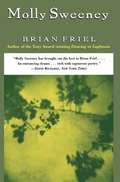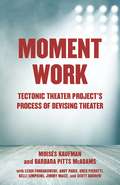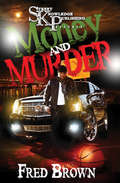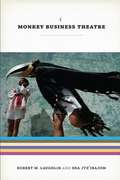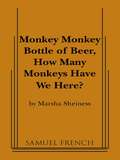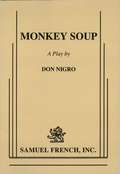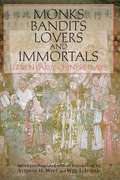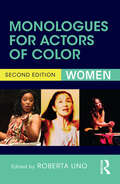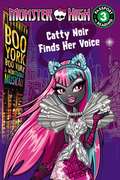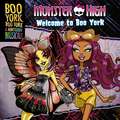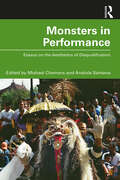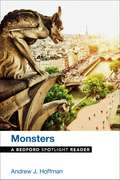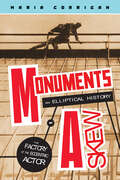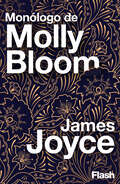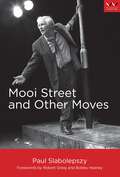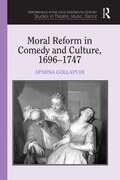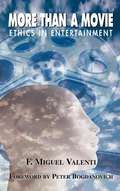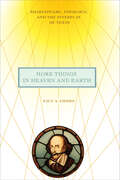- Table View
- List View
Molly Sweeney
by Brian Friel<p>From one of Ireland’s best living playwrights, this striking piece of dramatic writing is a daring piece of theater. Keeping the play’s three characters on stage at all times to speak directly to the audience, Brian Friel presents three points of view to the same intriguing tale. Molly herself, blind since she was an infant, tells of her world before and after an operation to try to restore her sight. Her husband, itinerant champion of good causes, talks of his passion to help her. Her once famous eye surgeon, now a whiskey-sodden recluse in Donegal, sees the operation as his chance to reclaim his reputation. Each of their voices interweaves, threading in and out with details, spinning a lush and sensate narrative, and carrying us effortlessly to an unexpected and poignant conclusion. <p>Deceptively simple, yet richly multilayered—combining both an insightful story about the way we perceive our existence with an allegory for our times—Molly Sweeney is an Irish storyteller’s art to create an unforgettable theater piece, painting scenery and rousing emotions with nothing more than the simple purity of beautifully rendered words.</p>
Mom, Dad, I'm Living With A White Girl
by Marty ChanA Chinese son must tell his parents he has moved in with his white girlfriend. In a counter-narrative, the play explodes Asian stereotypes in a B-movie spoof called Wrath of the Yellow Claw.
Moment Work: Tectonic Theater Project's Process of Devising Theater
by Moises Kaufman Barbara Pitts McAdamsA detailed guide to the collaborative method developed by the acclaimed creators of The Laramie Project and Gross Indecency--destined to become a classic. A Vintage Original.By Moisés Kaufman and Barbara Pitts McAdams with Leigh Fondakowski, Andy Paris, Greg Pierotti, Kelli Simpkins, Jimmy Maize, and Scott Barrow. For more than two decades, the members of Tectonic Theater Project have been rigorously experimenting with the process of theatrical creation. Here they set forth a detailed manual of their devising method and a thorough chronicle of how they wrote some of their best-known works. This book is for all theater artists—actors, writers, designers, and directors—who wish to create work that embraces the unbridled potential of the stage.
Momologues 2: Off To School
by Lisa RaffertyThe MOM crew is at it again! MOMologues2: Off to School offers a frank and funny look at the true tales of motherhood, from homework hell to multitasking mania. Four separate characters tell their individual stories, either directly to the audience in monologues, or in scenes with each other. Moms everywhere will laugh in recognition at the playdates gone wrong, the crazy way to get a Mom day off, how to stalk a potential babysitter and much more.
Money and Murda
by Fred BrownMoney grew up in one of the most dangerous projects in Brooklyn. With the help of his right hand man, he became a boss of a multi-million dollar drug ring. He supplied over 70% of the cocaine in New York City and surrounding areas. The five boroughs, the streets... the grimest hoods and projects are familiar with his name however, it's only very small inter circle that recognize him by his face. His people raise the murder rate throughout the city. If you cross the line, have your casket and tombstone ready. A hard nose, relentless veteran NYPD detective refuses to retire, until he finds out who the invisible leader is, this powerful cartel that the streets are scared to talk about and law agencies can not infiltrate. Murder is the most sought after high school basketball player in the country. He is expected to be a 1st round draft pick in the NBA. He lives in a small town that puts up B.G. numbers in the drug trade. He refuses to stop balling in the streets. He has a decision to make, either way, Murder will be balling!! When Money and Murder meet "The Game" is played... The way the Game is supposed to be played and everybody eats!!!
Monkey Business Theatre
by Robert M. LaughlinIn 1983, a group of citizens in San Cristóbal de las Casas, Chiapas, formed Sna Jtz'ibajom, the Tzotzil-Tzeltal Maya writers' cooperative. In the two decades since, this group has evolved from writing and publishing bilingual booklets to writing and performing plays that have earned them national and international renown. Anthropologist Robert M. Laughlin has been a part of the group since its beginnings, and he offers a unique perspective on its development as a Mayan cultural force. The Monkey Business Theatre, or Teatro Lo'il Maxil, as this branch of Sna Jtz'ibajom calls itself, has presented plays in virtually every corner of the state of Chiapas, as well as in Mexico City, Guatemala, Honduras, Canada, and in many museums and universities in the United States. It has presented to the world, for the first time in drama, a view of the culture of the Mayas of Chiapas. In this work, Laughlin presents a translation of twelve of the plays created by Sna Jtz'ibajom, along with an introduction for each. Half of the plays are based on myths and half on the social, political, and economic problems that have confronted--and continue to confront--the Mayas of Chiapas. In 1983, a group of citizens in San Cristóbal de las Casas, Chiapas, formed Sna Jtz'ibajom, the Tzotzil-Tzeltal Maya writers' cooperative. In the two decades since, this group has evolved from writing and publishing bilingual booklets to writing and performing plays that have earned them national and international renown. Anthropologist Robert M. Laughlin has been a part of the group since its beginnings, and he offers a unique perspective on its development as a Mayan cultural force. The Monkey Business Theatre, or Teatro Lo'il Maxil, as this branch of Sna Jtz'ibajom calls itself, has presented plays in virtually every corner of the state of Chiapas, as well as in Mexico City, Guatemala, Honduras, Canada, and in many museums and universities in the United States. It has presented to the world, for the first time in drama, a view of the culture of the Mayas of Chiapas. In this work, Laughlin presents a translation of twelve of the plays created by Sna Jtz'ibajom, along with an introduction for each. Half of the plays are based on myths and half on the social, political, and economic problems that have confronted - and continue to confront - the Mayas of Chiapas.
Monkey Monkey Bottle of Beer, How Many Monkeys Have We Here?
by Marsha SheinessDrama \ Marsha Sheiness \ 6 f., 1 child. \ Int. \ This psychological mystery is set in the waiting room of a clinic where five mothers await word on the futures of their retarded children. They have been given the opportunity to change their children into geniuses, and the play explores the hopes, fears and guilt of each woman. As the drama moves forward, the very nature of parent child love is examined. \ "A gallery of characters interestingly and richly observed." N.Y. Times.
Monkey Soup
by Don NigroFull length, farce / 5m, 3f / Unit set / Set on the stage of a New York theatre in the 1930s, this demented, madcap, no holds barred, galloping farce is a loving parody and homage to the sort of movie the Marx Brothers might have made after a hundred cups of coffee with their hair on fire. The language is rapid fire and the physical comedy is maniacal. Mrs. Lillian Quackenfurter, a once renowned actress, has written the worst play in the history of the theatre, Lady Furtwinger's Lover, which she hopes to star in to revive her career after a forty year hiatus, and has hired a person she believes to be the internationally renowned director, Dr Cornelius T. Fartwhistle, a rude, fast-talking con man who insults her constantly and makes hash of her play. He's actually a dentist named Hassenfusser who accidentally killed Fartwhistle with laughing gas while filling a cavity. The stage manager, Boccalucci, and his wild, girl-chasing, mute assistant, Goosey, who have worked with the real Fartwhistle in the past (and slept with his wife) blackmail Fartwhistle-Hassenfusser into letting them appear in the play, planning to disable the other actors by feeding them bad fish and putting vodka in the water cooler. Lucy the maid is determined to get through her exposition, despite the fact that she's forced to talk into a goose instead of a telephone, and is being constantly bombarded by bird carcasses. Edgar is insanely jealous over his blond bombshell wife Thelma, who is unconscious for much of the second act. Dick, the leading man, plays tennis and announces that he has three balls. Somebody has put tranquilizer darts in the prop gun. Non-stop lunacy.
Monkey's Uncle
by Roger KarshnerFarce / Roger Karshner / 4 m. 2 f. / Interior / Ernie loves apes and Fred collects leaves. And the two of them get together every Saturday to play Chinese checkers. During one of the games, Fred fakes dying of a heart attack. Ernie and his wife, Dottie, put Fred in their son's room and leave to get Harold, Fred's daffy nephew. During their absence their son, Clyde, returns home from college unexpectedly with his girlfriend, Sybil. When Sybil suggests they make love Clyde goes to his room and finds a "stiff" Fred in his bed. He panics, causing Sybil to run out into the night scantily clad thinking she doesn't turn Clyde on anymore. Now Clyde, assuming his dad has knocked off Fred, decides to get rid of the body by exchanging it with a stuffed ape. From this point on it's a whirlwind of apes, leaves, worms, ant farms, blackmail, misunderstandings and madness. But it all comes out in the wash.
Monks, Bandits, Lovers, and Immortals: Eleven Early Chinese Plays
by Wilt L. Idema Stephen H. WestThis magnificent collection of eleven early [1250–1450] Chinese plays will give readers a vivid sense of life and a clear understanding of dramatic literature during an extraordinarily eventful period in Chinese history. Not only are the eleven plays in this volume expertly translated into lively, idiomatic English; they are each provided with illuminating, scholarly introductions that are yet fully intelligible to the educated lay reader.
Monologues for Actors of Color: Women
by Roberta UnoActors of colour need the best speeches to demonstrate their skills and hone their craft. Roberta Uno has carefully selected monologues that represent African-American, Native American, Latino, and Asian-American identities. Each monologue comes with an introduction and notes on the characters and stage directions to set the scene for the actor. This new edition now includes more of the most exciting and accomplished playwrights to have emerged over the 15 years since the Monologues for Actors of Color books were first published, from new, cutting edge talent to Pulitzer winners.
Monster High: Catty Noir Finds Her Voice
by Perdita FinnA new Monster High leveled reader movie tie-in! © 2015 Mattel. All Rights Reserved.Passport to Reading Level 2
Monster High: Welcome to Boo York
by Perdita FinnIt's fright lights, big city when the Monster High ghouls head to Boo York. Cleo de Nile is invited to attend a fancy gala celebrating the return of a magical comet and, of course, she brings along her beast friends. But their trip isn't all fun and frightseeing because Nefera, Cleo's sister, uses the comet's powers for her own spooktacularly sneaky plans. Can the monsters unwrap the mystery of the comet in time to stop Nefera?
Monsters in Performance: Essays on the Aesthetics of Disqualification
by Analola Santana Michael ChemersMonsters in Performance boasts an impressive range of contemporary essays that delve into topical themes such as race, gender, and disability, to explore what constitutes monstrosity within the performing arts. These fascinating essays from leading and emerging scholars explore representation in performance, specifically concerning themselves with attempts at social disqualification of "undesirables." Throughout, the writers employ the concept of "monstrosity" to describe the cultural processes by which certain identities or bodies are configured to be threateningly deviant. The editors take a range of previously isolated critical inquiries – including bioethics, critical race studies, queer studies, and televisual studies - and merge them to create an accessible and dynamic platform which unifies these ranges of representations. The global scope and interdisciplinary nature of Monsters in Performance renders it an essential book for Theatre and Performance students of all levels as well as scholars; it will also be an enlightening text for those interested in monstrosity and Cultural Studies more broadly.
Monsters: A Bedford Spotlight Reader
by Andrew J. HoffmanMonsters seem to be everywhere, and it's easy to see why: they're fun. Young and old pile into movie theaters to watch the latest releases from Hollywood featuring both the scary and the attractive–carnivorous zombies, love-struck vampires, bloodthirsty werewolves, even methodical serial killers.
Monuments Askew: An Elliptical History of the Factory of the Eccentric Actor (Media Matters)
by Maria CorriganMonuments Askew: An Elliptical History of the Factory of the Eccentric Actor presents a cultural history of the Factory of the Eccentric Actor (FEKS), an avant-garde collective of Ukrainian artists whose unique approach to monumental history generated a new kind of cinema for a modernizing Soviet era. Often lost in the shuffle of this period, FEKS’s vibrant and experimental cinematic output initiated a youthful and cheeky overhaul of Soviet revolutionary culture. Monuments Askew reveals the foundational role of this understudied group of artists—including Grigori Kozintsev and Leonid Trauberg—and uses their own theoretical contributions to undo the “foundations” of our understanding of Soviet media and arts. As a counter to a solely cinema-focused conceptualization of this era, Corrigan develops a transnational media theory of eccentricity. Defining eccentric circles as warped, irregular orbits that force a realignment of centers, Monuments Askew shows how FEKS’s body of work inspires an eccentric realignment of the pillars of Soviet visual culture, and indeed of monumentality itself.
Monuments and Literary Posterity in Early Modern Drama
by Brian ChalkIn spite of the ephemeral nature of performed drama, playwrights such as Marlowe, Jonson, Webster, Fletcher, and Shakespeare were deeply interested in the endurance of their theatrical work and in their own literary immortality. This book re-evaluates the relationship between these early modern dramatists and literary posterity by considering their work within the context of post-Reformation memorialization. Providing fresh analyses of plays by major dramatists, Brian Chalk considers how they depicted monuments and other funeral properties on stage in order to exploit and criticize the rich ambiguities of commemorative rituals. The book also discusses the print history of the plays featured. The subject will attract scholars and upper-level students of Renaissance drama, memory studies, early modern theatre, and print history.
Monólogo de Molly Bloom
by James JoyceUn hito de la literatura inglesa moderna: el soberbio y pasional soliloquio de Molly Bloom. «[...] me gustaría que algún hombre cualquiera me cogiese alguna vez cuando él está aquí y me besase entre sus brazos no hay cosa como un beso largo y caliente que te baja por el alma casi te paraliza [...]» Cien años después de su publicación, las palabras de Molly Bloom, que cierran el gran canto épico del siglo XX que es el Ulises, siguen dejando a cualquier lector sin aliento. Sin signos de puntuación, a través del denominado «flujo de consciencia», Molly se convierte en una Penélope moderna que toma la palabra y zambulle al lector en sus pensamientos más profundos. Consciente de su complicada situación matrimonial con Leopold Bloom, tan solo le queda echar un vistazo atrás a la infancia, a sus hijos, a sus deseos más íntimos, a su radical mundanidad. Publicado por Sylvia Beach en la mítica librería parisina Shakespeare and Company en 1922, no cabe duda de que el Ulises, la obra magna de James Joyce, marcó un antes y un después en la modernidad literaria. Y no hay mejor manera de celebrar su centenario que leyendo el pasaje que encumbró al escritor irlandés. Sobre la obra y el autor:«Si tuviera que perderse todo lo que se llama literatura moderna y hubiera que salvar dos libros, esos dos libros que podríamos elegir en todo el mundo serían en primer término el Ulises y luego el Finnegans Wake, de Joyce».Jorge Luis Borges «Algo completamente nuevo. Ha logrado superar en intensidad a todos los novelistas de nuestra época.»William Butler Yeats «Ulises de Joyce es el eslabón entre los dos grandes mundos, el clásico y el del caos».George Steiner «Malditamente maravilloso».Ernest Hemingway «Había leído la novela con algo parecido a la veneración [...]. Lo leí con una dedicación queno he vuelto a tener nunca».Juan Gabriel Vásquez, El País «Un libro con el que todos estamos en deuda, y del que ninguno de nosotros puede escapar».T. S. Eliot «Cada página es maravillosa y compensa el esfuerzo».Joyce Carol Oates «Una obra de arte divina que vivirá para siempre».Vladimir Nabokov «Lo devoré en un verano con espasmos de asombro y de descubrimiento».Virginia Woolf «Navegué por primera vez en el Ulises con catorce años. Y digo navegar y no leer porque, como nos recuerda su título, el libro es como un océano; no lo lees, navegas a través de él».John Berger «Joyce está siempre en mi mente, lo llevo a todas partes conmigo. Construyó un universo a partir de un grano de arena: eso fue toda una revelación».Salman Rushdie «A veces pienso que preferiría no haberlo leído: me hace sentir inferior. Volver a mi obra tras un libro así es como si un eunuco quisiera tener voz debarítono».George Orwell
Mooi Street and Other Moves
by Paul SlabolepszyA collection of six plays by South Africa’s leading playwright and actor featuring works written between 1984 and 1993.
Moonlight Cocktail
by Steven KeyesFull Length, Comedy 3 m, 2 f Unit set This bittersweet comedy of human errors opens in an East Texas trailer park where tensions are at the boiling point. Waitress and aspiring actress Patsy Tyson is preparing for her local theatre debut, arousing her ne'r do well husband Ed's suspicions as a growing attraction develops with her leading man. Casting a wary eye on the lovebirds, Ed enlists his reluctant pal Duke to join the production. As the romantic complications mount, opening night approaches and they all must finally face a harsh reality in the light of day. With a style that takes realism to the borders of the ridiculous, Moonlight Cocktail explores human follies with an effortless and lyrical humor. "Tightly written and entertaining [with] well-rounded characters."-Backstage
Moral Reform in Comedy and Culture, 1696-1747 (Performance In The Long Eighteenth Century: Studies In Theatre, Music, Dance Ser.)
by Aparna GollapudiIn the first half of the eighteenth century, a new comic plot formula dramatizing the moral reform of a flawed protagonist emerged on the English stage. The comic reform plot was not merely a generic turn towards morality or sentimentality, Aparna Gollapudi argues, but an important social mechanism for controlling and challenging political and economic changes. Gollapudi looks at reform comedies by dramatists such as Colley Cibber, Susanna Centlivre, Richard Steele, Charles Johnson, and Benjamin Hoadly in relation to emergent trends in finance capitalism, imperial nationalism, political factionalism, domestic ideology, and middling class-consciousness. Within the context of the cultural anxieties engendered by these developments, Gollapudi suggests, the reform comedies must be seen not as clichéd and moralistic productions but as responses to vital ideological shifts and cultural transvaluations that impose a reassuring moral schema on everyday conduct. Thoroughly researched and elegantly written, Gollapudi's study shows that reform comedies covered a range of contemporary concerns from party politics to domestic harmony and are crucial for understanding eighteenth-century literature and culture.
More Alternative Shakespeare Auditions for Women
by Simon DunmoreFollowing on his successful Alternative Shakespeare Auditions for Women, Simon Dunmore presents even more underappreciated speeches that will make a classical audition sound fresh.
More Art in the Public Eye
by Emma Drew Micaela Martegani Jeff KasperMore Art in the Public Eye offers critical insight into the ever-growing field of socially engaged public art by demonstrating how the committed collaboration of artists, community members, and cultural producers can meaningfully impact our collective futures. Presented through the lens of More Art's fifteen-year history, the public art projects featured in this book expose issues of systemic inequality and injustice, stoke debate, and inspire alternatives. Artists and participants reflect on their works in newly conducted interviews, while essays from thinkers and actors in the field help situate the projects and the mission of socially engaged art in terms of greater cultural and political paradigms. More Art in the Public Eye establishes the framework for the conditions under which organizations like More Art operate, highlights the many meta-questions behind socially engaged public art, and seeks to amplify the wide array of voices that make up a project.Contributors. Rebecca Amato, Michael Birchall, Ofri Cnaani, Michelle Coffey, Jennifer Dalton, Emma Drew, Pablo Helguera, Mary Jane Jacob, Jessica Lynne, Jeff Kasper, Kimsooja, Micaela Martegani, Andrea Mastrovito, Tony Oursler, William Powhida, Ernesto Pujol, Michael Rakowitz, Kirk Savage, Dread Scott, Andres Serrano, Gregory Sholette, Xaviera Simmons, Krzysztof Wodiczko
More Than A Movie: Ethics In Entertainment
by E. Miguel ValentiIn More Than a Movie, producer and entertainment attorney F. Miguel Valenti presents a compelling argument for the creative community to consider the consequences of its products, from movies to TV to the Internet. Valenti refrains from attacking the industries in which he himself works, but argues for reflection on the part of those who create media. More Than a Movie takes a pioneering first step toward outlining the issues in an insider fashion, and provides the tools to make ethical decisions about creating for the big and small screens. More Than a Movie is written to stimulate debate in professional and academic arenas, and for the enjoyment of everyone who loves entertainment.
More Things in Heaven and Earth: Shakespeare, Theology, and the Interplay of Texts (Richard E. Myers Lectures)
by Paul S. FiddesShakespeare’s plays are filled with religious references and spiritual concerns. His characters—like Hamlet in this book’s title—speak the language of belief. Theology can enable the modern reader to see more clearly the ways in which Shakespeare draws on the Bible, doctrine, and the religious controversies of the long English Reformation. But as Oxford don Paul Fiddes shows in his intertextual approach, the theological thought of our own time can in turn be shaped by the reading of Shakespeare’s texts and the viewing of his plays.In More Things in Heaven and Earth, Fiddes argues that Hamlet’s famous phrase not only underscores the blurred boundaries between the warring Protestantism and Catholicism of Shakespeare’s time; it is also an appeal for basic spirituality, free from any particular doctrinal scheme. This spirituality is characterized by the belief in prioritizing loving relations over institutions and social organization. And while it also implies a constant awareness of mortality, it seeks a transcendence in which love outlasts even death. In such a spiritual vision, forgiveness is essential, human justice is always imperfect, communal values overcome political supremacy, and one is on a quest to find the story of one’s own life. It is in this context that Fiddes considers not only the texts behind Shakespeare’s plays but also what can be the impact of his plays on the writing of doctrinal texts by theologians today. Fiddes ultimately shows how this more expansive conception of Shakespeare is grounded in the trinitarian relations of God in which all the texts of the world are held and shaped.
